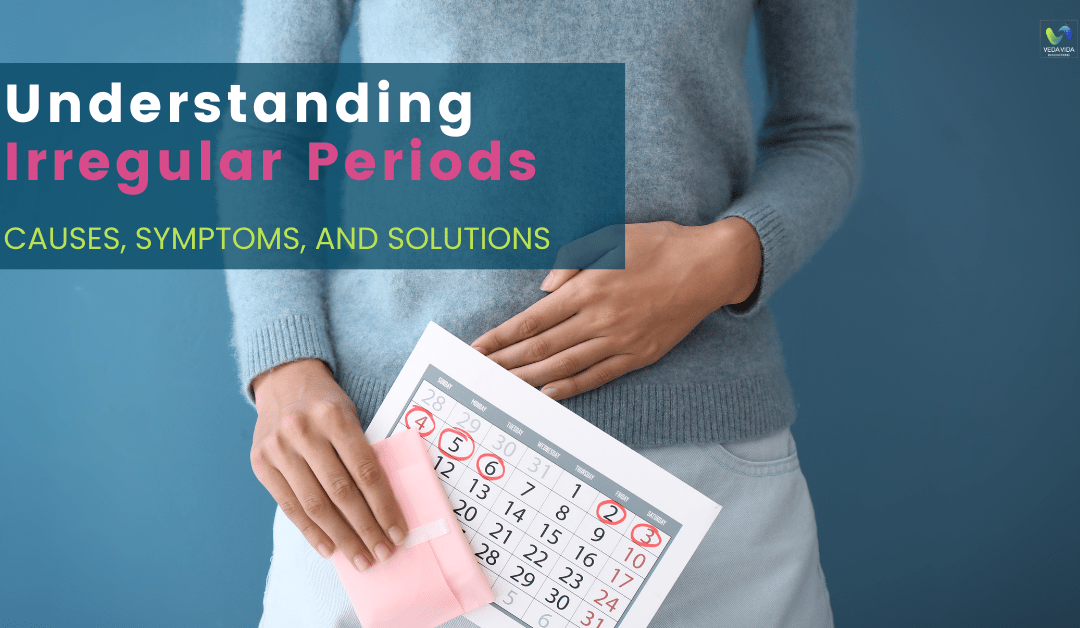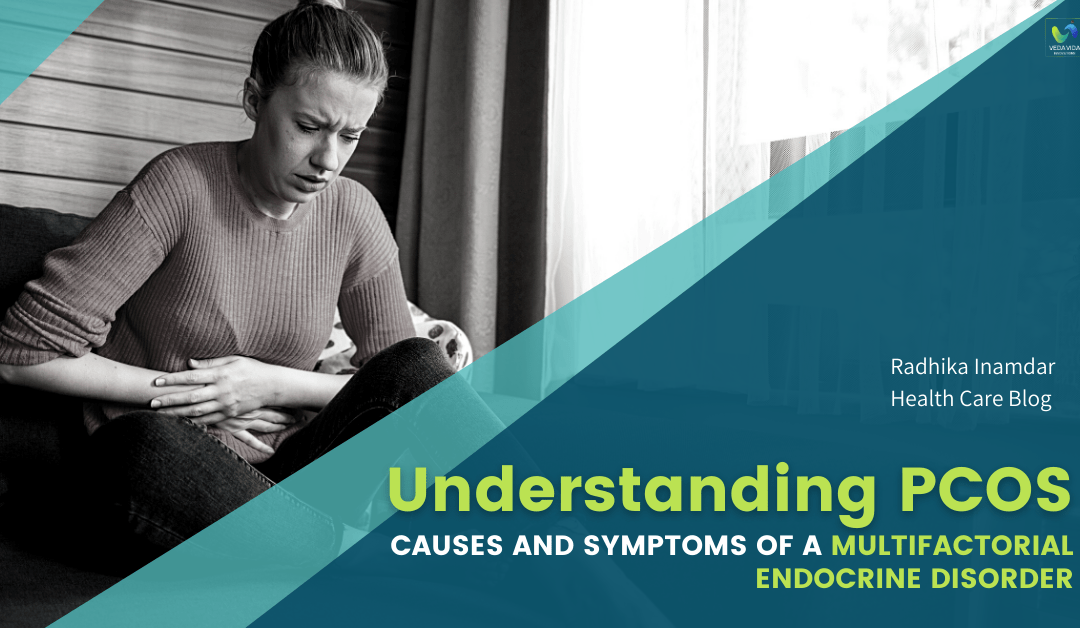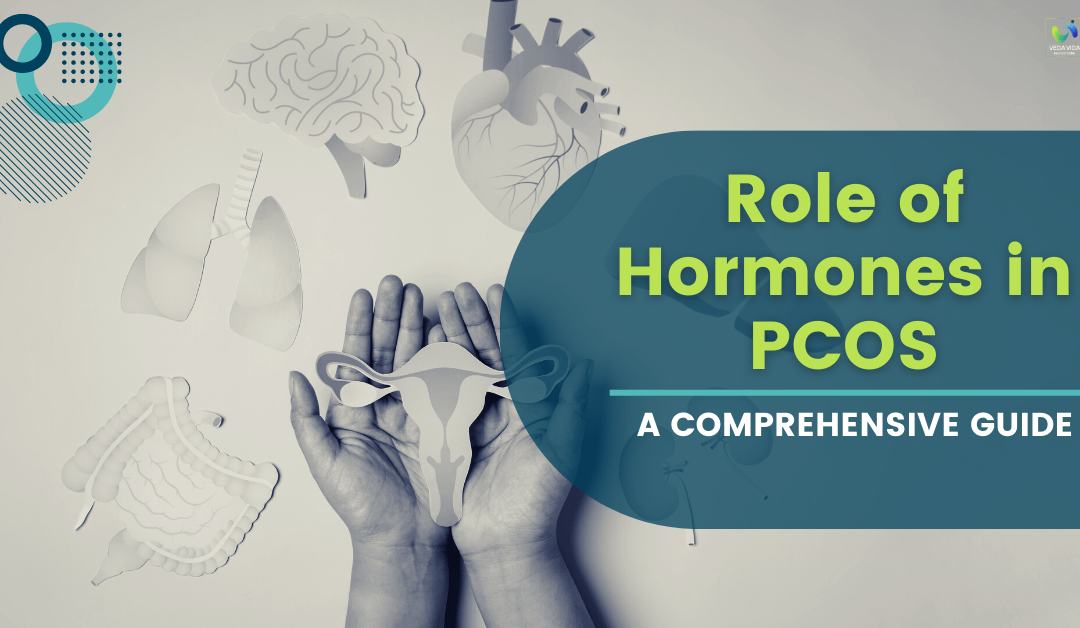
by nikita pustake | 11 Jul, 2023 | Female’s Health
Are you tired of receiving notifications from your period tracker app about irregular periods? Or are you frustrated with your menstrual cycle’s unpredictable behavior? Are your periods arriving like an uninvited obnoxious guest who is not ready to leave? If your periods are arriving unexpectedly or lasting longer than usual, you may be experiencing irregular periods.
Typically, a menstrual period lasts for four to seven days and occurs every 28 days. However, if your menstrual cycle ranges from 21 to 35 days, it is still considered regular. But if you experience any of the following period issues, you may have irregular periods:
- Menstrual cycles occurring less than 21 days or more than 35 days apart
- Skipping periods for three or more consecutive months
- Heavier or lighter bleeding than usual
- Periods lasting more than seven days
- Experiencing pain, cramping, nausea, or vomiting during periods
- Bleeding or spotting between periods, after menopause, or following sex
At Veda-Vida Innovations, we understand the challenges that come with irregular periods. Our Sushumna range of products offers solutions to common period issues.
Here are some of the major period issues that women face:
- Heavy periods (Menorrhagia): If your flow is so heavy that you need to change your tampon or pad every hour for at least an entire day, you may have menorrhagia. This condition can be caused by hormonal imbalances, growths in the uterus, certain IUDs, pregnancy problems, female cancers, medications, endometriosis, thyroid problems, pelvic inflammatory disease (PID), kidney disease, liver disease, and other factors.
- Light periods (Hypomenorrhea): Hypomenorrhea is a condition in which you experience extremely light or scanty blood flow during menstruation. If you produce only 20-30ML of blood instead of the usual 30-80ML, you may have this condition. Hypomenorrhea can be caused by hormonal imbalances, PCOS, stress, birth control pills, hyperthyroidism, sudden weight loss or weight gain, menopause, certain medications, and other factors.
- Infrequent periods (Oligomenorrhoea): If you experience infrequent periods that don’t occur for more than 35 days, have less than nine periods a year, and experience PMS symptoms such as mood swings, tiredness, bloating, and abdominal cramps, you may have oligomenorrhoea. You may notice that the blood is a darker brown shade or is very faint, and small clots are present. This condition can be caused by hormonal imbalances, lifestyle changes, excessive physical activity, being overweight or obese, PCOS, primary ovarian insufficiency, thyroid disorders, diabetes, pelvic inflammatory disease, anatomical defects in the uterus, vagina, cervix, steroid or other medication usage, and other factors.
- Absence of periods (Amenorrhea): Amenorrhea is the absence of menstruation, often defined as missing one or more menstrual periods. Symptoms of this condition include headaches, vision changes, nausea, extra facial hair, hair loss, changes in breast size, milky fluid or discharge from breasts, or no breast development. Amenorrhea can be caused by hormonal imbalances, family history, genetic or chromosomal defects, being severely overweight or underweight, eating disorders, extreme exercise, poor diet, stress, PCOS, some birth control methods, depression medications, chemotherapy, thyroid or pituitary gland issues, blood pressure, hypothalamic disease, uterine scar tissue, pregnancy, breastfeeding, and menopause.
In conclusion, irregular periods are a common issue faced by many women, and it can be caused by a variety of factors ranging from hormonal imbalances to lifestyle choices. However, it’s essential to identify and address the underlying causes to prevent any long-term health complications. With the Veda-Vida Innovations’ Sushumna range of products, you can tackle any menstrual issues effectively and regain control of your cycle. It’s always advisable to consult a medical professional if you’re experiencing any severe or persistent symptoms. Take charge of your menstrual health and live your life to the fullest.

by Veda Vida | 11 Jul, 2023 | Female’s Health
Understanding Menopause Symptoms: Do You Really Need Lab Tests for Diagnosis?
Menopause is a natural phase in a woman’s life that marks the end of her reproductive years. As women approach this stage, they may experience a range of symptoms that can be both physical and emotional. While many women are familiar with the common symptoms associated with menopause, such as hot flashes, night sweats, mood changes, and irregular periods, there is often confusion about the necessity of lab tests for diagnosis. In this article, we will explore whether or not lab tests are truly required to determine if a woman is going through menopause.
First and foremost, it is important to note that menopause is a natural process, and the presence of symptoms alone can indicate its onset. Hot flashes, night sweats, changes in mood, irregular periods, weight gain, thinning hair, dryness of the skin and vagina, and lower sex drive are some of the most common symptoms experienced by women transitioning into menopause. If you are experiencing these symptoms and are in the age range typically associated with menopause (usually between 45 and 55), it is likely that you are indeed going through this natural aging process.
While it is true that a doctor can assist in confirming the onset of menopause, it is not always necessary to rely on lab tests to do so. Hormonal tests, such as measuring Follicle Stimulating Hormone (FSH) and estrogen levels, have traditionally been used to determine menopausal onset. However, these tests may not always be accurate indicators, as hormonal fluctuations can vary greatly during the perimenopause phase, leading to inconsistent results.
Furthermore, hormonal therapy, such as the use of birth control pills, can significantly impact the FSH and estradiol tests, further complicating their reliability. This is why alternative diagnostic tests, such as the Anti-Müllerian hormone (AMH) Elisa test, have been developed to predict the onset of menopause more accurately. The AMH test measures a hormone produced by the ovaries, which can provide a more reliable indication of ovarian reserve and the proximity to menopause.
It is important to highlight that while lab tests may not be necessary for the diagnosis of menopause itself, they may still have a role to play in certain circumstances. For example, if there is a concern that physical changes may be a sign of an underlying illness, such as a thyroid disorder, or if spontaneous menopause occurs at an early age, further testing may be warranted. In such cases, additional tests like thyroid function tests, prolactin levels, and other relevant investigations may be recommended based on a woman’s medical history and physical examination.
At Veda Vida, we understand the challenges and discomfort that can accompany menopause. We have developed an herb-based capsule called Sushumna-M, which is specifically designed to alleviate menopausal symptoms. It is made from 100% natural ingredients and has been formulated to provide relief without any side effects. However, we always encourage women to consult with their gynecologists or healthcare providers for proper diagnosis and treatment.
In conclusion, while lab tests may not be necessary to determine menopause, it is crucial to seek medical advice if you are experiencing symptoms associated with this natural aging process. Your doctor can help assess whether the symptoms are indeed indicative of menopause or if further investigation is required to rule out other underlying conditions. While our clinic offers a natural remedy for menopausal symptoms, it is always advisable to follow your doctor’s recommendation for proper diagnosis and treatment. Remember, menopause is a unique journey for every woman, and seeking professional guidance can ensure that you navigate this phase with comfort and confidence.

by nikita pustake | 11 Jul, 2023 | Female’s Health
Polycystic Ovary Syndrome (PCOS) is a complex endocrine disorder that affects millions of women worldwide. It is a multifactorial condition that can manifest in different ways and can cause a variety of symptoms that can greatly impact a woman’s quality of life. In this blog, we will discuss the four main characteristics of PCOS, which are anovulation, hyperandrogenism, insulin resistance, and polycystic ovarian morphology.
Anovulation
Anovulation is one of the main characteristics of PCOS. It occurs when an egg does not release from the ovary during the menstrual cycle, which can lead to irregular periods or no periods at all. Women with PCOS may also experience difficulty getting pregnant due to the lack of ovulation. Anovulation is caused by the hormonal imbalances that occur in PCOS, which can disrupt the normal functioning of the ovaries.
Hyperandrogenism
Hyperandrogenism is another hallmark of PCOS. It is a condition in which there is an excess of androgen hormones, particularly testosterone, in the bloodstream. This can cause a variety of symptoms, including acne, hirsutism (excessive hair growth), and male pattern baldness. Women with PCOS may also experience a deepening of the voice and an increase in muscle mass. Hyperandrogenism is caused by the overproduction of androgens in the ovaries, adrenal glands, or both.
Insulin Resistance
Insulin resistance is a common characteristic of PCOS. It occurs when the body’s cells become resistant to the effects of insulin, leading to an increase in insulin production. This can cause a variety of symptoms, including weight gain, fatigue, and an increased risk of developing type 2 diabetes. Women with PCOS may also experience difficulty losing weight, despite a healthy diet and regular exercise. Insulin resistance is thought to be caused by the hormonal imbalances that occur in PCOS, particularly the excess production of insulin and androgens.
Polycystic Ovarian Morphology
Polycystic ovarian morphology is the presence of multiple small follicles in the ovaries. These follicles can be seen on an ultrasound and are a characteristic feature of PCOS. The follicles are surrounded by theca cells, which are responsible for producing androgens. The excess androgen production in PCOS can lead to the development of these follicles. Polycystic ovarian morphology is not always present in women with PCOS, and its absence does not rule out the diagnosis.
In conclusion, PCOS is a complex endocrine disorder that can cause a variety of symptoms and impact a woman’s quality of life. The four main characteristics of PCOS are anovulation, hyperandrogenism, insulin resistance, and polycystic ovarian morphology. If you suspect you may have PCOS, it is important to speak with your healthcare provider to discuss your symptoms and develop a treatment plan that is right for you.

by nikita pustake | 11 Jul, 2023 | Female’s Health
Menopause is a natural biological process that every woman goes through, but it can be a challenging and uncomfortable time. There are typically three stages of menopause that a woman goes through: perimenopause, menopause, and post-menopause. By understanding the symptoms and changes that occur during each phase, women can better manage their physical and emotional health.
Perimenopause is the first stage of menopause and can last for several years. During this stage, your body begins to transition from the reproductive stage of life to menopause. You may experience irregular periods, hot flashes, mood swings, vaginal dryness, urinary issues, and other symptoms as your estrogen and progesterone levels start to drop. Perimenopause can begin as early as your 30s or as late as your 40s, and the experience is different for every woman.
Menopause is reached when you haven’t had a menstrual period for an entire year during the perimenopausal phase. This marks the end of your reproductive years, and your ovaries cease to produce estrogen and progesterone. Symptoms during this stage can include hot flashes, night sweats, mood changes, difficulty sleeping, and other physical and emotional changes.
Post-menopause is the final stage of menopause and begins when a woman has not had a period for one year. During this stage, the symptoms of menopause start to subside, but women may experience new health issues such as increased risk for heart disease, osteoporosis, and other conditions. It is important to maintain a healthy lifestyle and have regular checkups with your doctor to monitor your health.
In addition to the natural physical changes that occur during menopause, women may also experience an increased risk for several conditions such as diabetes, autoimmune disorders, joint pain, hepatitis C, gout, urinary tract infections, vaginal atrophy, and gum disease. It’s important to stay proactive about your health by maintaining a healthy weight, avoiding drugs and alcohol, getting consistent moderate exercise, and staying connected with friends and family.
If you are going through menopause, it’s essential to talk to your doctor about your symptoms and how to manage them effectively. You may also want to consider taking Veda Vida‘s SUSHUMNA-M to support your health and ease your transition through menopause. By taking care of your physical and emotional health, you can have a smooth and empowering journey through menopause.

by nikita pustake | 11 Jul, 2023 | Female’s Health
Polycystic Ovary Syndrome (PCOS)
is a hormonal disorder that affects up to 10% of women of reproductive age. The condition is characterized by the presence of multiple cysts in the ovaries, irregular menstrual cycles, and high levels of male hormones. In this blog, we’ll explore the hormones that play a significant role in PCOS and how they affect the body.
- Insulin
Insulin is a hormone produced by the pancreas that regulates blood sugar levels. Women with PCOS often have high levels of insulin due to insulin resistance, which means the body is not responding to insulin properly. High insulin levels can cause the ovaries to produce more androgens (male hormones), leading to symptoms such as acne, excess hair growth, and irregular periods.
- Androgens
Androgens are male hormones that are also present in women. In PCOS, the ovaries produce too much androgen, which can lead to symptoms such as acne, excess hair growth (hirsutism), and male-pattern baldness. High levels of androgens can also disrupt ovulation, leading to irregular menstrual cycles or a lack of periods.
- Estrogen
Estrogen is a female hormone that plays a crucial role in the menstrual cycle and pregnancy. In PCOS, the balance of estrogen and progesterone is disrupted, leading to irregular periods and difficulty getting pregnant. Some women with PCOS may also have low levels of estrogen, which can cause vaginal dryness and other symptoms.
- Progesterone
Progesterone is a hormone produced by the ovaries after ovulation. It helps regulate the menstrual cycle and prepare the body for pregnancy. Women with PCOS may not ovulate regularly, leading to low levels of progesterone and irregular periods.
- Follicle-stimulating hormone (FSH)
FSH is a hormone produced by the pituitary gland that stimulates the ovaries to produce eggs. In PCOS, the levels of FSH are often lower than normal, leading to irregular ovulation and menstrual cycles.
- Luteinizing hormone (LH)
LH is a hormone produced by the pituitary gland that stimulates the ovaries to produce androgens. Women with PCOS often have high levels of LH, which can lead to excess androgen production and other symptoms.
In conclusion, PCOS is a complex hormonal disorder that involves several different hormones. High levels of insulin, androgens, and LH, as well as low levels of estrogen, progesterone, and FSH, can all contribute to the symptoms of PCOS. If you suspect you have PCOS, it’s essential to speak to your healthcare provider to get an accurate diagnosis and appropriate treatment.

by Veda Vida | 8 May, 2023 | Female’s Health
Managing Polycystic ovary syndrome (PCOS)with Diet:
Polycystic ovary syndrome (PCOS) is a hormonal disorder that affects 1 in 10 women, making it one of the most common hormonal disorders in women of reproductive age. Polycystic ovary syndrome can lead to infertility, weight gain, insulin resistance, acne, and hair growth. However, the good news is that you can manage PCOS with a healthy lifestyle, diet, and natural supplements. In this blog, we share five crucial things that you need to prioritize in your diet to manage PCOS with ease.
Maintain your meal timings
One of the most important things that you can do for your body is to maintain regular meal timings. As dietitian, Rupali Karajgir suggests, “You have to take care of your body. No one else can come and take care of your meal timings.” She emphasizes the need to have frequent meals at the same time every day, with healthy munching in between. This helps your hormones to function better and takes care of other stomach-related issues as well. Studies have shown that women who maintain regular meal timings have better insulin sensitivity, weight management, and hormone regulation.
Take fennel seeds after every meal
Fennel seeds (Saunf) are a small thing but can be very helpful in taking care of your sugar cravings. Women with PCOS often experience food cravings, especially for sugary foods. By taking fennel seeds after every meal, you can delay your sugar cravings. Recent studies have also shown that 1 tsp of fennel seeds post-lunch and 1 tsp post-dinner can reduce FSH/LH/testosterone, resulting in regular menstrual cycles. Fennel seeds are also a good source of antioxidants, which reduces oxidative stress and menstrual pain found in Polycystic ovary syndrome.
Increase your dietary fibers intake
Dietary fibers intake is crucial for everyone, especially for women with Polycystic ovary syndrome. As dietitian, Rupali Karajgir recommends, “You have to increase your dietary fibers intake. With every major meal (especially lunch and dinner), you must have one full bowl of salads. This will take care of your dietary fibers intake. Indian diet is cereal-based. We need to use flour with bran. Use millets in your diet.” By increasing your dietary fibers intake, you can improve your digestion and manage your weight. Dietary fibers-rich foods like whole grains, fruits, and vegetables help in reducing insulin resistance, inflammation, and other metabolic issues.
Prioritize fresh food over processed food
Women with Polycystic ovary syndrome should prioritize fresh food over processed food. Processed foods, including bakery items, biscuits, ketchup, juices, chips, and pickles, are harmful to your health, especially when you have Polycystic ovary syndrome. Instead of consuming fruit juices, have the whole fruit to get the best benefits out of it. Eating fresh food helps you manage your weight and hormonal imbalances. Whole foods are rich in antioxidants, dietary fibers, and nutrients that your body needs to function optimally.
Take more fluids and a mood-uplifting diet
Mood swings are a common symptom of Polycystic ovary syndrome. To tackle mood swings, you can try taking more fluids and having a mood-uplifting diet. Fruits, vegetables, natural sharbat like Bel Sharbat and Nimbu Sharbat (Lemonade), and natural fluids like coconut water or even sometimes coffee (in limited quantity) are mood-uplifting things that take care of your mood swings. Don’t forget to have proper exercise with all of the above. Exercise helps in reducing stress, improving insulin sensitivity, and overall well-being.
In conclusion, Polycystic ovary syndrome is a hormonal disorder that affects many women worldwide. However, it is a manageable condition with a healthy lifestyle, diet, and natural supplements. Prioritizing regular meal timings, taking fennel seeds after meals, increasing dietary fibers intake, prioritizing fresh food over processed food, and taking more fluids and a mood-uplifting diet can help you manage the symptoms of Polycystic ovary syndrome. These lifestyle changes, combined with proper exercise and natural supplements like Sushumna P, can help you lead a healthier life with PCOS. Remember that PCOS is a lifestyle disorder, and by making healthy lifestyle choices, you can start to reverse the symptoms and improve your overall well-being.
Polycystic ovary syndrome (PCOS) is a hormonal disorder that affects 1 in 10 women, making it one of the most common hormonal disorders in women of reproductive age. Polycystic ovary syndrome can lead to infertility, weight gain, insulin resistance, acne, and hair growth. However, the good news is that you can manage PCOS with a healthy lifestyle, diet, and natural supplements. In this blog, we share five crucial things that you need to prioritize in your diet to manage PCOS with ease.





